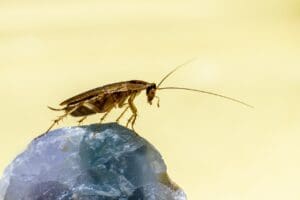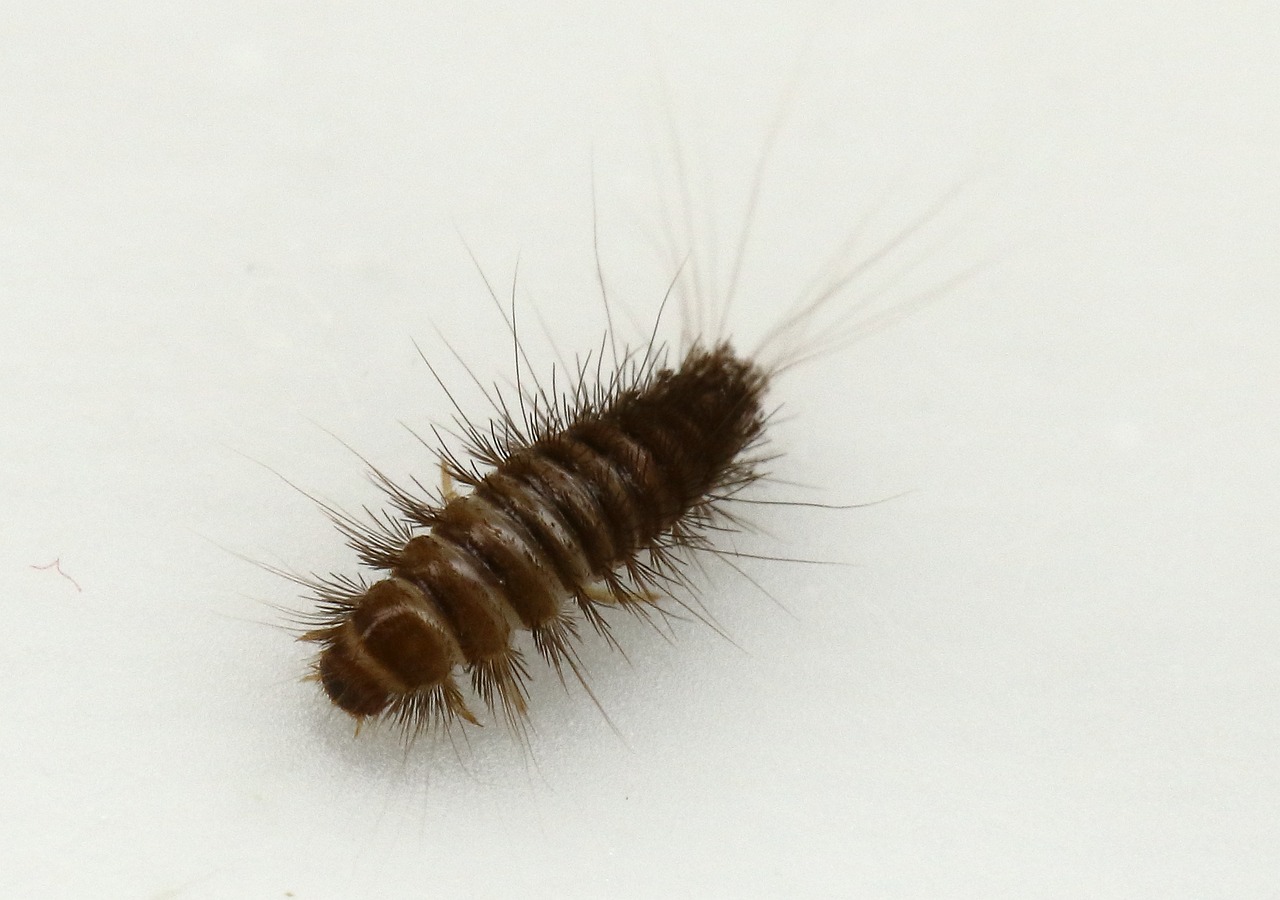Though carpet beetles are a mere nuisance pest, the damage they cause can be devastating; they cannot tell the difference between a family heirloom and an old rag, nor do they care. A closet full of animal-made fabrics is like an all-you-can-eat buffet for carpet beetles, and once they move into one, they can be very difficult to eradicate. Fear not, though- after reading this guide you will be armed with everything you need to know about carpet beetles and how to prevent them.
What Are Carpet Beetles?
Carpet beetles are oval-shaped insects whose larvae like to eat through fabrics. Adults grow to be between 2 and 5 mm in length. They have short clubbed antennae and chewing mouthparts. The colors and patterns of adult carpet beetles vary by species. Most are some shade of brown or black and some have mottled patterns of white, yellow, orange, or red. Carpet beetle larvae resemble maggots in shape and size. They range from light brown to black in color and all species have some amount of bristly hairs on their bodies. Some species are hairier than others. Larvae are typically between 3 and 7 mm long. Are carpet beetles dangerous? Carpet beetles are a nuisance pest but they do their fair share of damage. Unlike many other pests, the larvae of carpet beetles are the real hazard while adults are virtually harmless. Larvae feed on animal-based materials like fur, leather, silk, wool, and feathers. Their feeding habits cause serious damage to items like clothing, furniture, carpets and rugs, down comforters and pillows, taxidermy mounts, and anything else made from animal products. They will sometimes eat plant-based items as well like seeds, grains, and pet food. In addition to damaging products, larvae also pose very minor health risks. They shed their bristly hairs into clothing and carpets which can cause skin irritation. As they grow, they also shed their skins which can cause dermatitis and allergic reactions in some people. Signs of Carpet Beetles
Carpet Beetle Carcasses
The first sign of carpet beetles that most people come across is carpet beetles themselves. Dead adult beetles build up on windowsills, indicating an infestation. Skins that have been shed by larvae can also be found. Eggs
During May and June, adults lay eggs on materials that larvae can eat. The white or cream-colored eggs are tiny and oval with a spine-like projection at one end. Look for them on or near any animal-based materials. Damage
Damage from carpet beetles appears in a few different ways. Primarily, larvae chew holes in fabrics. This damage is often mistaken for clothes moth damage. The way to tell the two pests apart is by the holes they make; carpet beetles typically chew one large hole, while clothes moths chew many small holes. Carpet beetle damage may also appear as thin, bare spots on rugs and furless areas of garments and taxidermy mounts. Where To Look For Carpet Beetles
Carpet beetles are usually found near the larvae’s food sources. Closets, chests, and wardrobes are some of the most common spots, but they can also be found in storage areas, along the edges and undersides of rugs, and anywhere with an accumulation of pet hair (i.e. pet beds and baseboards). Larvae also feed on dead insects and can be found wherever there is a surplus of them- for instance in light fixtures or chimneys. Since carpet beetle larvae sometimes eat plant-based materials, be sure to check pantries and pet food storage spaces for signs of activity. How To Prevent Carpet Beetles
- Properly store all vulnerable items. All animal-based materials should be cleaned thoroughly before being stored. Hair, skin, and bodily oils that are left behind will attract carpet beetles. Unfortunately, chests and wardrobes alone will not keep out these pests, so all Items should be kept in airtight garment bags or containers. Furs can also be placed in cold storage. Storing items with essential oils like peppermint or clove oil may help deter carpet beetles.
- Clean regularly. As mentioned above, hair, skin, and bodily oils attract carpet beetles. As such, it is important to vacuum carpets and floors regularly, especially in areas where pets like to hang out. Drapes and upholstered furniture should be vacuumed as well. Dusting regularly can also help to remove skin and hair particles.
- Remove food sources. It is virtually impossible to completely remove all larval food sources, but adults only feed on flower pollen; try to limit the number of flowering plants immediately outside of your home or business. In addition, promptly clean up food spills and store pantry and pet food in airtight containers.
- Eliminate entrances. Carpet beetles often enter homes and businesses through open doors and windows or through broken screens. As such, it is important to seal gaps around doors or windows, replace torn weather-stripping, and patch up holes in screens. Carpet beetles are sometimes brought in on plants, so be sure to thoroughly check both potted and freshly cut flowers before bringing them indoors.
These fabric-eating pests frequently go unnoticed until significant damage has already been done. At the first sign of carpet beetle activity on your property, give Twin-Boro a call and we’ll make sure your stored fabrics remain safe from carpet beetles.


